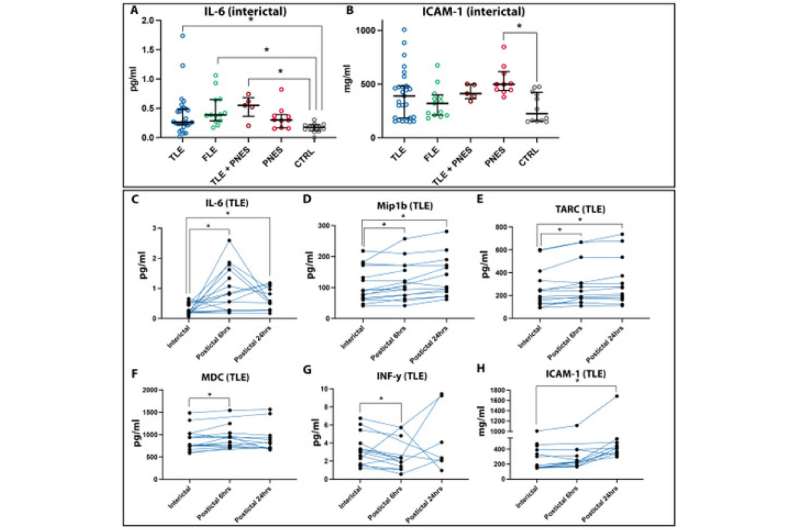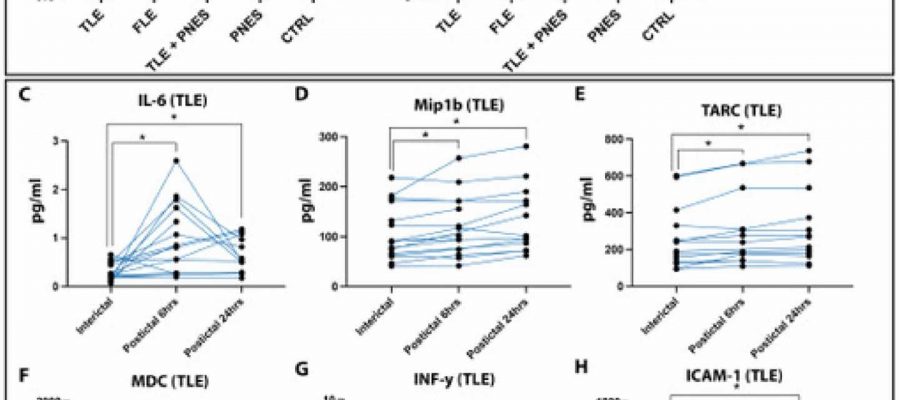
Researchers from Lund University in Sweden have discovered higher levels of immune proteins in the blood before and after an epileptic seizure. The possible biomarkers can be identified using a simple blood test. Diagnosing epilepsy is currently resource intensive, and distinguishing it from other conditions can be challenging. Better diagnostic methods as soon as the patient seeks medical care after a suspected seizure are therefore an urgent necessity.
Epilepsy is the collective name for abnormal activity in the brain that causes temporary loss of control of behavior and movement. The condition can be congenital, be caused by a tumor, stroke or infection in the brain and cause very different symptoms depending on which part of the brain the episode begins in or spreads to. Inflammation processes that start as an immune response in the body can also provoke a seizure.
That is why researchers started to look for possible biomarkers for epilepsy within the immune system. Previous studies exist, but the results have so far been mixed and difficult to interpret:
“In our study, we have a carefully selected group of participants and we have a lot of background information on each person. We have also taken into account a number of confounding factors that may affect the immune system such as other neurological and immunological illnesses, infections and various psychiatric conditions,” says Christine Ekdahl Clementson.
She is a group leader and associate professor at Lund University and a Consultant in Clinical Neurophysiology at Skåne University Hospital. Her focus is on advanced epilepsy investigations and she has led the research study. The research team have also compared epileptic seizures with what are known as psychogenic non-epileptic seizures.
Psychogenic seizure is a psychiatric diagnosis that manifests itself through clinical symptoms that can easily be mistaken for epilepsy. It is a chronic condition that is believed to be underdiagnosed and as a result is often mistakenly treated with epilepsy medication. That is why there is a great need to be able to distinguish between the conditions more easily.
“The investigation to establish whether someone is suffering from epilepsy or is affected by psychogenic seizures is resource intensive. It may require the patient to be admitted to hospital for several days with constant video and EEG surveillance, with medical staff on hand around the clock. It is hard on the patient that it takes time to reach a diagnosis,” says Marie Taylor, physician and doctoral student in the research team.
Researchers discovered that levels of five inflammation markers—proteins—were elevated acutely in people who had experienced an epileptic seizure.
“We call these markers ‘fingerprints’ since they involve several inflammation-related proteins with different reaction patterns. The patients who had epilepsy showed raised levels of one of the five proteins—IL-6—even before their seizures, a value that transiently raised even further directly after the seizure,” says Marie Taylor.
Among patients with psychogenic seizures, however, there was no change in the biomarkers. This might mean that a simple blood test on a patient arriving at A&E after a seizure can show whether the immunological response is elevated. If it is not, there is a greater chance that it is a matter of a psychogenic seizure, which provides a first indication of how the patient should be further assessed.
“The next stage is to repeat our studies on a broader and less homogenous patient group, where we investigate the ‘fingerprint’ in adults with epilepsy. We also want to see whether the biomarkers respond in the same way in children, where the causes of epilepsy are more often genetic. We are doing this through an ongoing study in Lund, in collaboration with child and adolescent psychiatry as well as pediatric neurology,” Christine Ekdahl Clementson concludes.
The study is published in the journal Heliyon.
More information:
Matilda Ahl et al, Immune response in blood before and after epileptic and psychogenic non-epileptic seizures, Heliyon (2023). DOI: 10.1016/j.heliyon.2023.e13938
Journal information:
Heliyon
Source: Read Full Article
